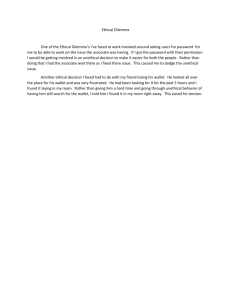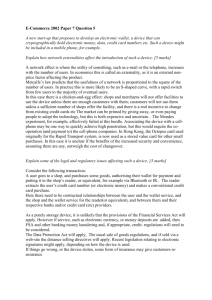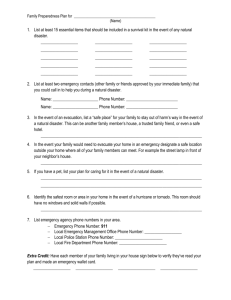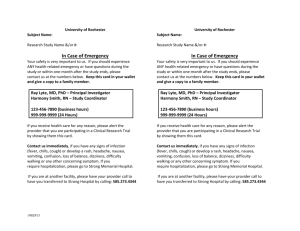lost mislaid memo 1 - Cleveland
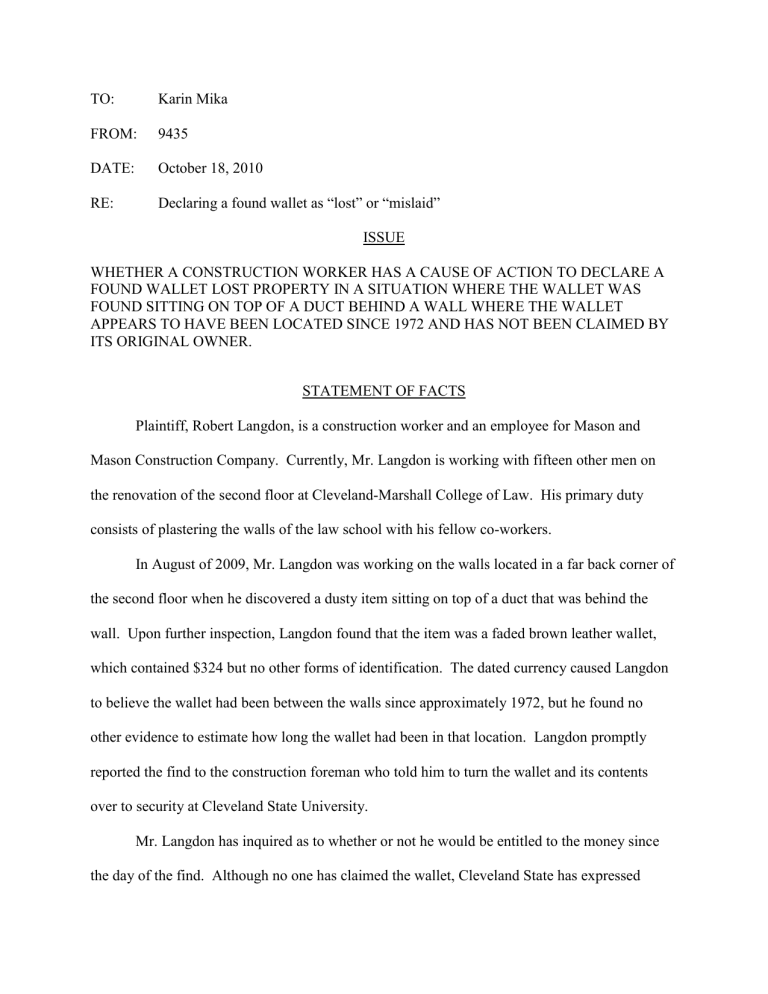
TO: Karin Mika
FROM: 9435
DATE: October 18, 2010
RE:
Declaring a found wallet as “lost” or “mislaid”
ISSUE
WHETHER A CONSTRUCTION WORKER HAS A CAUSE OF ACTION TO DECLARE A
FOUND WALLET LOST PROPERTY IN A SITUATION WHERE THE WALLET WAS
FOUND SITTING ON TOP OF A DUCT BEHIND A WALL WHERE THE WALLET
APPEARS TO HAVE BEEN LOCATED SINCE 1972 AND HAS NOT BEEN CLAIMED BY
ITS ORIGINAL OWNER.
STATEMENT OF FACTS
Plaintiff, Robert Langdon, is a construction worker and an employee for Mason and
Mason Construction Company. Currently, Mr. Langdon is working with fifteen other men on the renovation of the second floor at Cleveland-Marshall College of Law. His primary duty consists of plastering the walls of the law school with his fellow co-workers.
In August of 2009, Mr. Langdon was working on the walls located in a far back corner of the second floor when he discovered a dusty item sitting on top of a duct that was behind the wall. Upon further inspection, Langdon found that the item was a faded brown leather wallet, which contained $324 but no other forms of identification. The dated currency caused Langdon to believe the wallet had been between the walls since approximately 1972, but he found no other evidence to estimate how long the wallet had been in that location. Langdon promptly reported the find to the construction foreman who told him to turn the wallet and its contents over to security at Cleveland State University.
Mr. Langdon has inquired as to whether or not he would be entitled to the money since the day of the find. Although no one has claimed the wallet, Cleveland State has expressed
intent to hold onto the money as being “mislaid.” Once the appropriate statutory time period has passed, Cleveland State plans to seek recovery of the amount for the University. Mr. Langdon now seeks to have the wallet declared as “lost” property.
DISCUSSION
Two general rules apply to the current issue. The rule regarding lost property is that property is considered lost if the owner unintentionally and involuntarily parts with its possession through “neglect, carelessness, or inadvertence” and has no knowledge of its whereabouts. Terry v. Lock , 37 S.W.3d 202, 206 (Ark. 2001). The rule regarding mislaid property is that property is considered mislaid when the owner intentionally and voluntarily places it in a particular location with intent to reclaim the property, but later overlooks or forgets where it was placed. Benjamin v. Linder , 534 N.W.2d 400, 406 (Iowa 1995). When determining whether property is lost or mislaid, the court tends to consider what the property is, the location where the property was found, whether the original owner has claimed the property, and the duration it has remained unclaimed. Toledo Trust Co. v. Simmons , 3 N.E.2d 661, 663 (Ohio Ct.
App. 1935). Here, because the wallet was found sitting on a duct behind a wall, rather than on the ground, the original owner seemingly displayed intent to place the item in that location and later return to claim it. As a result, the court will likely conclude that the property was mislaid.
Given the facts are not clear as to whether anyone has ever asked about it in the last thirty years, the length of time the wallet has been in the wall may not be relevant. As a result, Langdon’s cause of action will be unlikely to succeed.
There are several cases that demonstrate how courts distinguish between lost and mislaid property. In Terry v. Lock , the Supreme Court of Arkansas held that the currency found under a ceiling tile was mislaid property. 37 S.W.3d at 209.
In Terry , independent contractors
discovered a cardboard box concealed next to a heating and air vent. Id. at 203. The dusty box was filled with old currency totaling over $38,000 and became visible only after the appellants removed ceiling tiles. Id.
at 203, 204. In finding that the property was mislaid rather than lost, the court reasoned that because of the box’s concealed location, it was likely that the property was intentionally placed near the covered vent for its security, “in order to shield it from unwelcome eyes” and that it was likely the original owner placed it there with the intent to return. Id. at 208. Thus, the court concluded that the money was mislaid property rather than lost and determined that the motel owners obtained superior interest in the money than the renovators. Id.
In Benjamin , the court held that the packet of currency found under the airplane panel was mislaid. 534 N.W.2d at 407. In this case, plaintiff, an employee of Linder Aviation, discovered two packets of currency totaling over $18,000 concealed in the wing of an airplane.
Id. at 403. The packages found were carefully tied and encased with aluminum foil. Id. In finding that the property was mislaid rather than lost, the court determined that, “the place where
Benjamin found the money and the manner in which it was hidden” are important in this case.
Id. at 406. Because the currency was carefully hidden and concealed, the court reasoned it was likely that the original owner intentionally placed the money in this location for safekeeping, with the intent to retain ownership. Id.
at 408. The court thus concluded that the property was mislaid rather than lost and rightfully belonged to the owner of the plane. Id.
Conversely, in Toledo Trust Co. v. Simmons , the court held that an envelope with money found on the floor of a bank was lost property. 3 N.E.2d at 663. In this case, the plaintiff was a bank employee who found an unmarked envelope enclosed with $500 lying on the floor of an entryway to the safety deposit department.
Id. at 662. There was little evidence as to the owner
of the money due to the fact that the entryway was used by a number of persons, including individuals that were not customers of the bank. Id. Since found, the money had remained unclaimed by the original owner for fifteen years. Id. at 663.
In finding the money was lost rather than mislaid, the court focused on the substantive fact that the property was found in a public or semipublic place and that there was no evidence as to the original owner. Id. The court reasoned the best proof that the money found was lost property is the fact that the money went unclaimed for fifteen years. Id.
Thus, the court concluded that the money was lost rather than mislaid property and determined the employee was entitled to rightful possession and custody of the property, subject to the right of the original owner. Id.
Based on case law, it seems unlikely that Langdon’s cause of action will succeed in declaring the found wallet lost property. The general rule regarding lost property is that the owner must involuntarily part with its possession and have no knowledge of its whereabouts; however, when classifying found property, the court also considers what the property is, the location where it is found, whether the original owner has attempted to claim it, and the time period it has remained unclaimed. Id . Most analogous to our case is Terry v. Lock , in Terry , the court determined that the currency found in the cardboard box was mislaid property. 37 S.W.3d at 209. The court reasoned that because of the box’s location, it was likely that the property was intentionally placed near the covered vent “for its security, in order to shield it from unwelcome eyes” and that it was likely the original owner placed it there with the intent to return.
Id.
at 208.
Here, the facts are analogous to Terry , since the wallet was found sitting on a duct, the original owner seemingly displayed intent to place the item in that location and later return to claim it.
The property in question was not in plain view, therefore, an argument can be made that the
original owner may have been a construction worker that intentionally placed the wallet on the duct for safekeeping while working on site, with the intent to return for it after completing the work at hand. Thus, considering the facts present, it is likely the court will declare the wallet as mislaid rather than lost property.
Another example of where the court deemed property as mislaid is found in Benjamin . In
Benjamin , the court determined the packet of currency found under the airplane panel was mislaid property. 534 N.W.2d at 407. The court reasoned, because the currency was carefully hidden and concealed, it was likely that the original owner intentionally placed the money in this location for safekeeping, with the intent to later return for it. Id.
Here, like Benjamin , the facts seemingly indicate that original owner intentionally placed the wallet on the duct in the far back corner of the second floor. An argument can be made that the wallet was intentionally placed in this location for security of the wallet’s contents. Like the found property in Benjamin , the wallet found contained currency ($324), but no other forms of identification as the original owner. In, Benjamin
, the court reasoned “both logic and common sense suggest that that it is unlikely for someone to voluntarily part with $18,000,” without the intent to return to claim it in the future. Id. at 406. Based on parallel circumstances in these cases, it is likely that the court will declare the wallet as mislaid property.
Langdon may allege various counter-arguments to support his position, focusing on factors other than intent when determining whether property is lost. Langdon may argue the length of time that the wallet has remained unclaimed by its original owner is relevant to the court’s decision. In
Toledo Trust Co.
, the court’s best evidence that the envelope was lost was that the money had remained unclaimed by its original owner for fifteen years. 3 N.E.2d at 663 .
The facts indicate that because of the dated currency, Langdon assumes the wallet has been
unclaimed for thirty years. However, unlike in Toledo Trust Co.
, there is no evidence as to how long the wallet has been in that location. An argument can be made that it is possible that the wallet was recently misplaced by one of Langdon’s fifteen current co-workers and its dusty exterior is attributed to current renovation and construction. Based on these facts, the period time the wallet has remained unclaimed may not be relevant.
Langdon may also allege that the manner in which the wallet was hidden is not analogous to cases where property is considered mislaid. In Benjamin , the packets of currency found under the airplane wing were “carefully tied and wrapped and then concealed in a location that was accessible” by removing a panel. 534 N.W. 2d at 406. Here, the wallet was located on a duct, behind a wall, a location unparallel to those cited in other mislaid cases. However, despite these assertions, an argument can be made that “a loss is always involuntary; there can be no intent to part with the ownership of lost property.” 37 S.W.3d at 206. Therefore, if a construction worker voluntarily placed the wallet on a duct with the intent to later return for it, the fact that a wall was later built and concealed the wallet, may not be relevant.
Langdon may also argue the public nature of the facility where the wallet was found is similar to cases in which the court held property lost. In determining the property as lost, rather than mislaid, the court in Toledo Trust Co., focused on the fact that the envelope was found in a public or semipublic place. 3 N.E.2d at 663 .
However, unlike in Toledo Trust Co.
, here, the wallet was found on a duct, rather than lying on the floor. Although both locations are in a public facility, the latter indicates the wallet was purposefully placed. Additionally, in Toledo Trust Co.
, “the safety deposit department then had between two hundred and three hundred customers,” which passed through the entryway where the envelope was found; however, here, the facts seemingly imply that the location was
restricted to the access of construction workers . Id. at 661. Based on these circumstances and their relation to the case at hand, it is unlikely that the court will declare the wallet lost property and the public nature of the facility may not be relevant.
CONCLUSION
Based on case law, it seems unlikely that Langdon’s cause of action will succeed in declaring the found wallet lost property. Two general rules apply to the issue at hand. Property is considered lost if the owner unintentionally parts with its possession and has no knowledge of its whereabouts. 37 S.W.3d at 206. Property is considered mislaid when the owner intentionally places it in a particular location with intent to reclaim it, but later overlooks or forgets where it was placed. 534 N.W.2d at 406. When classifying property, the court also considers what the property is, the location where it is found, whether the original owner has attempted to claim it, and the time period it has remained unclaimed. 3 N.E.2d at 663. Here, since the wallet was found sitting on a duct, it was likely that the original owner intentionally placed the property in this location for safekeeping, with the intent to later return for it.
Langdon’s strongest counter-argument asserts that the length of time the wallet has remained unclaimed is a significant factor in determining whether the property is lost or mislaid.
However, there is little evidence as to how long the wallet has actually been in that location.
Due to lack of evidence, this factor may not heavily weigh on the court’s decision. As a result, it is likely that the court will declare the wallet as mislaid, rather than lost property. Thus,
Cleveland State University will recover once the appropriate statutory time has passed.
